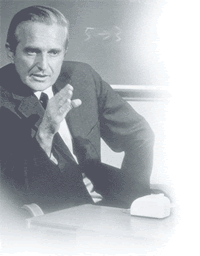Doug Engelbart Documentary Website. 
Have you ever used a mouse? Have you followed a link on a web page? Sent an email? Used a window on a computer? Used video teleconferencing? Then you live in Doug's world.
Back in November I posted some links to videos of Doug Engelbart's incredible work in the 1960s with technologies that I wouldn't use daily almost for another 3 decades: the mouse, windows, networking, email and more. It was awe-inspiring to see video of the birth of these literally world-changing technologies. Really incredible stuff.
There's a new website called Doug Engelbart's Invisible Revolution which has been created to track the progress on a new documentary about Doug and his effect on the computer industry (world?) as we know it. As they're planning on interviews with just about everyone in Silicon Valley, they're blogging about it (!) and putting clips online for viewing. Pretty rocking if you ask me. Right now, in addition to Doug himself there's also a clip from our favorite SmartMobber, Howard Rheingold who met Engelbart 20 years ago while writing Tools For Thought. Very cool stuff…
In addition to the neat stuff about Doug we're learning on the site (that he's still around and still interested in everything) you get to see a little behind-the-scenes about the process of making a documentary. I don't know if all documentaries are made this way, but its quite the shoe-string operation with the producers doing a lot of their work in Starbucks. 😉 Having gone to college New Hampshire and knowing several people who interned for Kevin Burns before he was the PBS superstar we all know now, I've got a general idea of what it's like (it's not Hollywood). This site is pretty interesting, if just for that.
Check it out… hopefully they'll put up a PayPal link or something up so we can help make sure the documentary sees the light of day, hey?
-Russ
Comment
[Russell Beattie Notebook]
Not only are we still feeding off the seminal work of Engelbart, we're still barely learning to listen to his deeper message, which was that we need to invest not only in the tools but in learning how to use them to good effect. Engelbart assumed that it would take time and effort to learn how to think better with these tools. That's certainly not a message we're going to hear from software marketers.
My wife is a photographer. If you want to piss her off, here's what to do. After admiring one of her pictures, ask her what kind of camera she uses. It's along the same lines as asking a writer what kind of pencil they use or what kind of keyboard.
Tools are important, but investing in learning how to take advantage of the tools is more important. There are two critical elements of in this learning. One of these is time, the other is play. Both are hard to come by in today's work environment.
